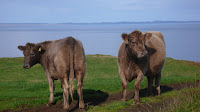
It has been a beautiful day, fresh and warm, with wonderful blue skies at times and gentle soft autumn light softened by light spitty clouds. The fields around the steadings are full of sheep. Each field with a different group. Alot of bleating as the newly weaned ewe lambs are calling for their mothers and some mothers call back. Those with the strongest bonds walk each side of the fence. Most of them, though, concentrate on fresh grass and learning the new flock order.
At certain times of the sheep year, strange things happen (!) - sheep change name and become something other than what they were.
When the main draw of lambs are sold, for example, as ours were this week, the ewe lambs we keep back for breeding stop being lambs and become Hoggs as soon as those lambs are sold.
When these Hoggs are first shorn at just over a year old they become Gimmers.
The Gimmers then become Ewes after they have had their first lambs.
It gets more complex with the Tups (males), and half the time I m not sure who is who is what. (A Tup is what the English call a Ram) And they can be Wedders, Shearlings, a 1 Shear, 2 Shear and so on.
Tonight, with our lambs sold, the field of ewe lambs is now a field of Hoggs. And very noisy some of them.
During the first 5 months of their lives the Hoggs have instinctively learnt the lie of the land from their mothers out on the hill. This means that they are 'hefted' to Treshnish.
Hefting is the knowledge and sense of the place where the animals are born. They learn from their mothers where to find water, shelter, shade, the sweetest grazings. And when they return to the hill next spring they will make use of that knowledge and a year on will pass on the same knowledge to their own lambs. (You could not easily introduce 'foreign' sheep to an open hill like this - with 4 miles of dramatic unfenced coastline and lots of cliff edges, unhefted sheep would not know how to get around, and gathering would be a nightmare).
But for now the Hoggs will stay together for the rest of the year until the spring. They will be taught how to 'feed'. Eating delicious supplementary food (such as 'sheep nuts' or hay) does not come naturally to sheep and so it is necessary to teach them so that in later life if you bring them in for lambing you can supplement their diet accordingly.
The ewes go back to the hill now and will recover their body condition before the winter now that their lambs are not taking milk from them any more.
The next time the ewes will come through the fank is when they come into the in-bye fields to meet the Tups.
It is now dark outside - the evening is quiet. Lights shining warmly from the Treshnish holiday cottage windows, scent of woodsmoke in the air. Bleating and baa-ing from the fields beginning to quieten down. Mixed feelings seeing the lambs go but excitement too as a new season begins.















































